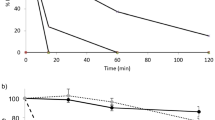Abstract
Purpose. The purpose of this study is to investigate the characteristics of pGlu-L-Dopa-Pro as a prodrug of L-Dopa.
Methods. pGlu-L-Dopa-Pro and L-Dopa-Pro were synthesized using the standard procedures of peptide synthesis. The conversion of pGlu-L-Dopa-Pro to L-Dopa was studied using pyroglutamyl aminopeptidase I and prolidase. With rats as the animal model, the stability of pGlu-L-Dopa-Pro in intestinal homogenates was determined, then the transport characteristics of pGlu-L-Dopa-Pro were studied using in-situ perfusion and Ussing chambers.
Results. pGlu-L-Dopa-Pro, relatively stable in intestinal homogenates and intestinal fluid, had a dimensionless permeability of 1.8 at 0.04 mM. Its intestinal permeability was significantly inhibited by 20 mM captopril, by a mixture of dipeptides, 80 mM Gly-Gly and 5 mM Gly-Pro, and by 2 mM cephradine. Further, in Ussing chambers, its mucosal to serosal permeability decreased dramatically with concentration. Conversion studies showed that pGlu-L-Dopa-Pro was degraded by pyroglutamyl aminopeptidase I, an enzyme releasing the N-terminal pyroglutamic acid, with Vmax and Km of 0.6 µmole/min/g protein and 21 mM, respectively, and that L-Dopa-Pro was degraded by prolidase with Vmax and Km of 44 µmole/min/g protein and 0.48 mM, respectively.
Conclusions. This tripeptide, a potential prodrug of L-Dopa, is absorbed by the intestinal peptide transporter, is relatively stable in the gut wall, and is converted to L-Dopa by peptidases with the cleavage by pyroglutamyl aminopeptidase I to L-Dopa-Pro as the rate limiting step.
Similar content being viewed by others
REFERENCES
N. Bodor, K.B. Sloan, T. Higuchi, Improved delivery through biological membrane. 4. prodrugs of L-Dopa, J. Med. Chem. 20:1435–1445, 1977.
J. G. Nutt, W. R. Woodward, J. H. Carter, Clinical and biomedical studies with controlled-release levodopa/carbidopa, Neurology 36:1206–1211, 1986.
S. J. Tye, N. M. J. Rupniak, T. Naruse, M. Miyaji, S. D. Iversen, NB-355: A novel prodrug for L-dopa with reduced risk for peak-dose syskinesias in MPTP-treated squirrel monkeys, Clin. Neurolpharmacol. 12: 393–403, 1989.
A. M. Felix, D. P. Winter, S. S. Wang, I. D. Kulesha, W. R. Pool, D. L. Hane, H. Sheppard, Synthesis and antireserpine activity of peptides of L-Dopa, J. Med. Chem. 7:422–426, 1974.
A. Garzon-Aburbeh, J. H. Poupaert, M. Claesen, P. Dumont, A lymphotropic prodrug of L-Dopa: synthesis, pharmacological properties, and pharmacokinetic behavior of 1,3-dihexadecanoyl-2-[(S)-2-amino-3-(3,4-dihydroxyphenyl)propanoyl]propane-1,2,3-triol, J. Med. Chem. 29:687–691, 1986.
J. A. Fix, J. Alexander, M. Cortese, K. Engle, P. Leppert, A. J. Repta, A comparison of oral and rectal absorption of L-dopa esters in rats and mice, Pharm. Res. 7:384–387, 1990.
Bai, Pei-Fan; Subramanian, P.; Mosberg, H. I. and Amidon, G. L. Structural requirements for the intestinal mucosal cell peptide transporter: The need for N-terminal α-amino group. Pharm. Res. 8(5):593–599, 1991.
Jane P. F. Bai and Amidon, G. L. Structural Specificity of Mucosal Cell transport and Metabolism of Amino Acids and Peptide Drugs: Implication for Oral Peptide Drug Delivery. Pharm. Res. 9(8):969–978, 1992.
P. Browne, G. O'Cuinn, An evaluation of the role of a pyroglutamyl peptidase, a post-proline cleaving enzyme and a postproline dipeptidyl aminopeptidase, each purified from the soluble fraction of guinea-pig brain, in the degradation of thyroliberin. Eur. J. Biochem. 137:75–87, 1983.
M. Donowitz and N. Asarkof. Calcium dependence of basal electrolyte transport in rabbit ileum. Am. J. Physiol. 243:G28–G35, 1982.
E. Quadros, N. M. Landzert, S. LeRoy, F. Gasparini, G. Worosila, Colonic absorption of insulin-like growth factor I in vitro. Pharm. Res. 11:226–230, 1994.
Y. Fuse, D. H. Polk, R. W. Lam, A. L. Reviczky, D. A. Fisher, Distribution and ontogeny of thyrothropin-releasing hormone degrading enzyme in rats, Am. J. Physiol. 259:E787–E791, 1990.
J. P. F. Bai, M. Hu; P. Subramanian, H.I. Mosberg and G. L. Amidon, Utilization of peptide carrier system to improve the intestinal absorption: Targeting prolidase as a prodrug converting enzyme. J. Pharm. Sci. 81:113–116, 1992.
G. L. Amidon, P. J. Sinko, D. Fleisher, Estimating human oral fraction dose absorbed: A correlation using rat intestinal membrane permeability for passive and carrier-mediated compounds. Pharm. Res. 5:651–654, 1988.
Author information
Authors and Affiliations
Rights and permissions
About this article
Cite this article
Bai, J.P.F. pGlu-L-Dopa-Pro: A Tripeptide Prodrug Targeting the Intestinal Peptide Transporter for Absorption and Tissue Enzymes for Conversion. Pharm Res 12, 1101–1104 (1995). https://doi.org/10.1023/A:1016239321494
Issue Date:
DOI: https://doi.org/10.1023/A:1016239321494




